

Virtual file system. A virtual file system (VFS) or virtual filesystem switch is an abstraction layer on top of a more concrete file system.
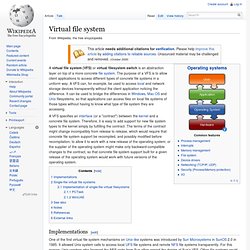
The purpose of a VFS is to allow client applications to access different types of concrete file systems in a uniform way. A VFS can, for example, be used to access local and network storage devices transparently without the client application noticing the difference. It can be used to bridge the differences in Windows, Mac OS and Unix filesystems, so that applications can access files on local file systems of those types without having to know what type of file system they are accessing.
Implementations[edit] Other Unix virtual file systems include the File System Switch in System V Release 3, the Generic File System in Ultrix, and the VFS in Linux. Hyper-V. Hyper-V, codenamed Viridian[1] and formerly known as Windows Server Virtualization, is a native hypervisor; it can create virtual machines on x86-64 systems.[2] Starting with Windows 8, Hyper-V supersedes Windows Virtual PC as the hardware virtualization component of the client editions of Windows NT.
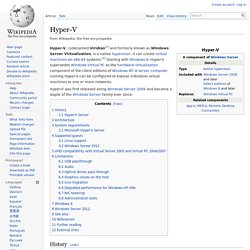
A server computer running Hyper-V can be configured to expose individual virtual machines to one or more networks. Hyper-V was first released along Windows Server 2008 and became a staple of the Windows Server family ever since. History[edit] A beta version of Hyper-V was shipped with certain x86-64 editions of Windows Server 2008. The finalized version was released on June 26, 2008 and was delivered through Windows Update.[3] Hyper-V has since been released with every version of Windows Server.[4][5][6] Microsoft provides Hyper-V through two channels: Oracle VM. Oracle VM is the server virtualization offering from Oracle Corporation.

Oracle VM Server for x86 incorporates the free and open-source Xen hypervisor technology, supports Windows, Linux, and Oracle Solaris[2] guests and includes an integrated Web based management console. Oracle VM features fully tested and certified Oracle Applications stack in an enterprise virtualization environment.[3] Oracle VM can be freely downloaded through Oracle Software Delivery Cloud.[4] Oracle announced the general availability of Oracle VM Release 3.2 in January 2013. Cooperative Linux. Cooperative Linux, abbreviated as coLinux, is software which allows Microsoft Windows and the Linux kernel to run simultaneously in parallel on the same machine.[4] Cooperative Linux utilizes the concept of a Cooperative Virtual Machine (CVM).
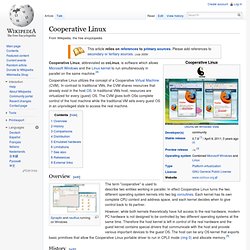
In contrast to traditional VMs, the CVM shares resources that already exist in the host OS. In traditional VMs host, resources are virtualized for every (guest) OS. The CVM gives both OSs complete control of the host machine while the traditional VM sets every guest OS in an unprivileged state to access the real machine. Overview[edit] The term "cooperative" is used to describe two entities working in parallel.
Comparison of platform virtual machines. Platform virtualization software, specifically emulators and hypervisors, are software packages that emulate the whole physical computer machine, often providing multiple virtual machines on one physical platform.

The table below compares basic information about platform virtualization hypervisors. General[edit] Features[edit] ^ Providing any virtual environment usually requires some overhead of some type or another. Native usually means that the virtualization technique does not do any CPU level virtualization (like Bochs), which executes code more slowly than when it is directly executed by a CPU. VirtualBox. Oracle VM VirtualBox (formerly Sun VirtualBox, Sun xVM VirtualBox and innotek VirtualBox) is a virtualization software package for x86 and AMD64/Intel64-based computers from Oracle Corporation as part of its family of virtualization products.
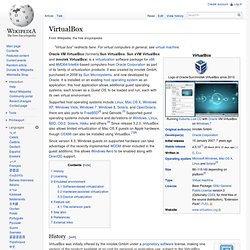
It was created by innotek GmbH, purchased in 2008 by Sun Microsystems, and now developed by Oracle. It is installed on an existing host operating system as an application; this host application allows additional guest operating systems, each known as a Guest OS, to be loaded and run, each with its own virtual environment. Since version 4.3, Windows guests on supported hardware can take advantage of the recently implemented WDDM driver included in the guest additions; this allows Windows Aero to be enabled along with Direct3D support. Virtual machine. A virtual machine (VM) is a software-based emulation of a computer. Virtual machines operate based on the computer architecture and functions of a real or hypothetical computer. Cloud Computing Services with VMware Virtualization - Cloud Infrastructure. Luckily you don’t need to rearchitect for different public cloud infrastructures.
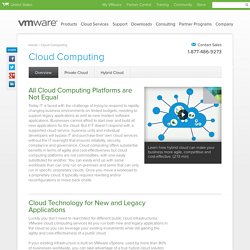
VMware cloud computing services let you run both new and legacy applications in the cloud so you can leverage your existing investments while still gaining the agility and cost-effectiveness of a public cloud. If your existing infrastructure is built on VMware vSphere, used by more than 80% of businesses worldwide, you can take advantage of a true hybrid cloud solution and extend your data center to the cloud quickly, easily and confidently. Because VMware vCloud Air is built on vSphere, your onsite and offsite IT environments can be connected and integrated, running existing and new applications in exactly the same way. You can get the same performance, security and compliance as you do from your current VMware infrastructure with the same agility, automation and standardization available in the cloud.
VMware vSphere. VMware vSphere, a holistic view.
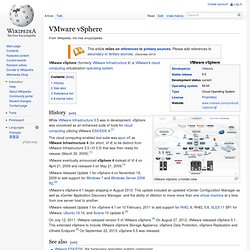
List of VMware software. VMware, Inc. is a US software company that provides cloud and virtualization software and services,[2][3][4] and claims to be the first to commercially successfully virtualize the x86 architecture.[5] Founded in 1998, VMware is based in Palo Alto, California.

In 2004 it was acquired by and became a subsidiary of EMC Corporation, then on August 14, 2007, EMC sold 15% of the company in a New York Stock Exchange IPO. The company trades under the symbol VMW.[6] History[edit] In 1998, VMware was founded by Diane Greene, Mendel Rosenblum, Scott Devine, Edward Wang and Edouard Bugnion. Greene and Rosenblum, who are married, first met while at the University of California, Berkeley.[8] Edouard Bugnion remained the chief architect and CTO of VMware until 2005,[9] and went on to found Nuova Systems (now part of Cisco). HyperOs Systems. 2X - Cloud Computing, Virtual Desktop Infrastructure (VDI) & Application Delivery, Server Based Computing (SBC) Solutions.
The web resource for bootable Media´s. Windows Virtual PC: Home Page. VMware is Virtual Infrastructure. Multibooting Home.